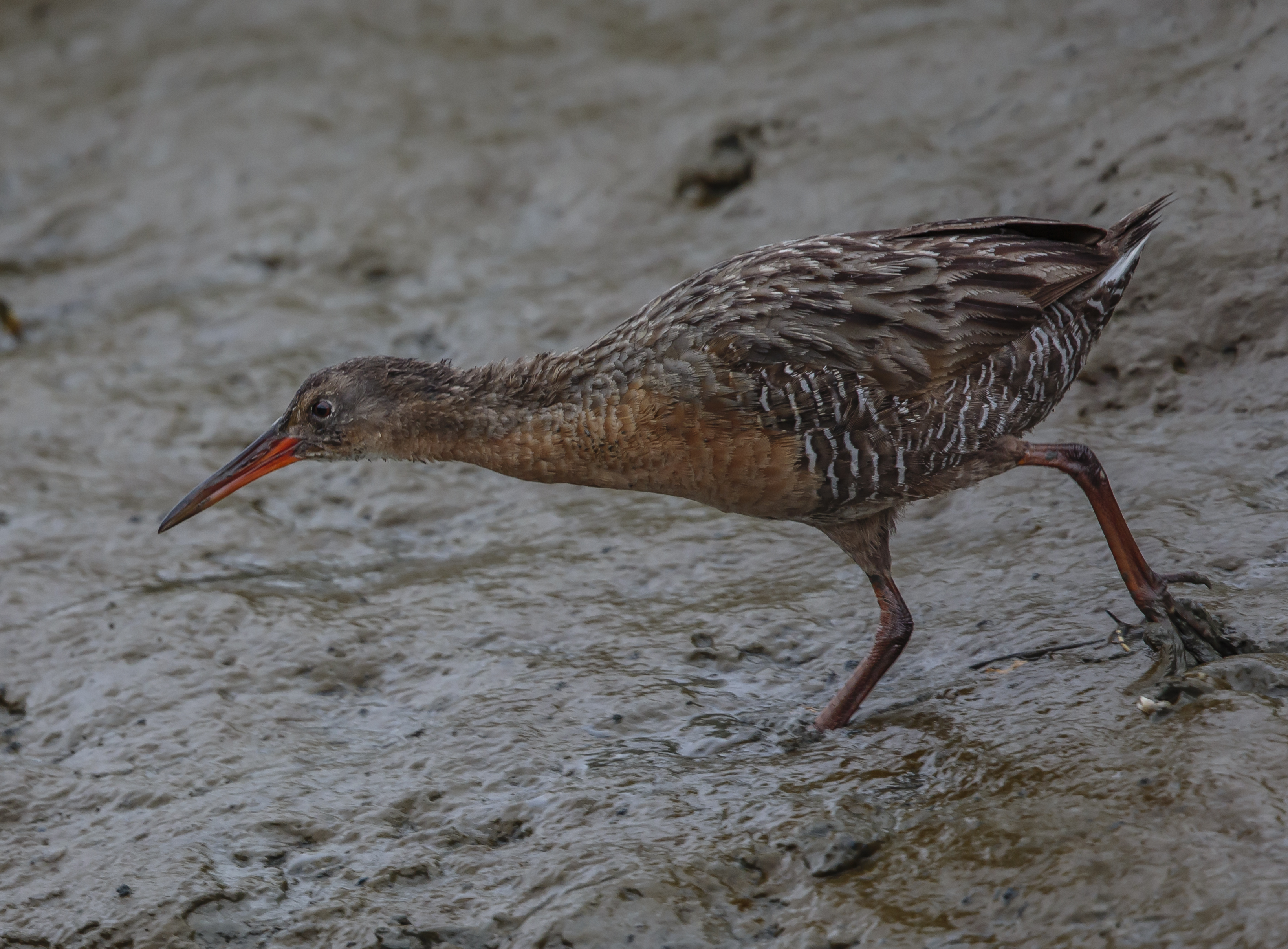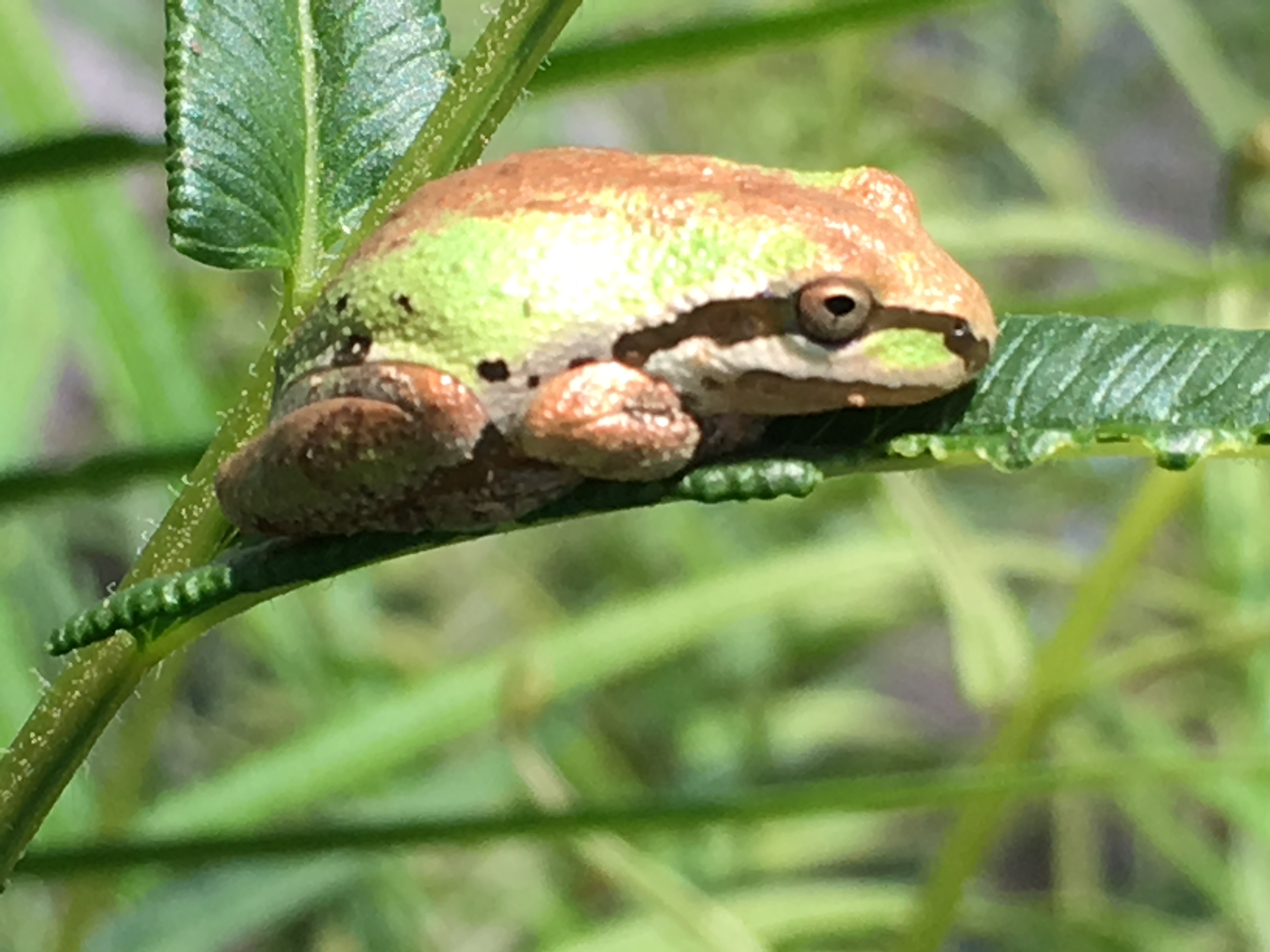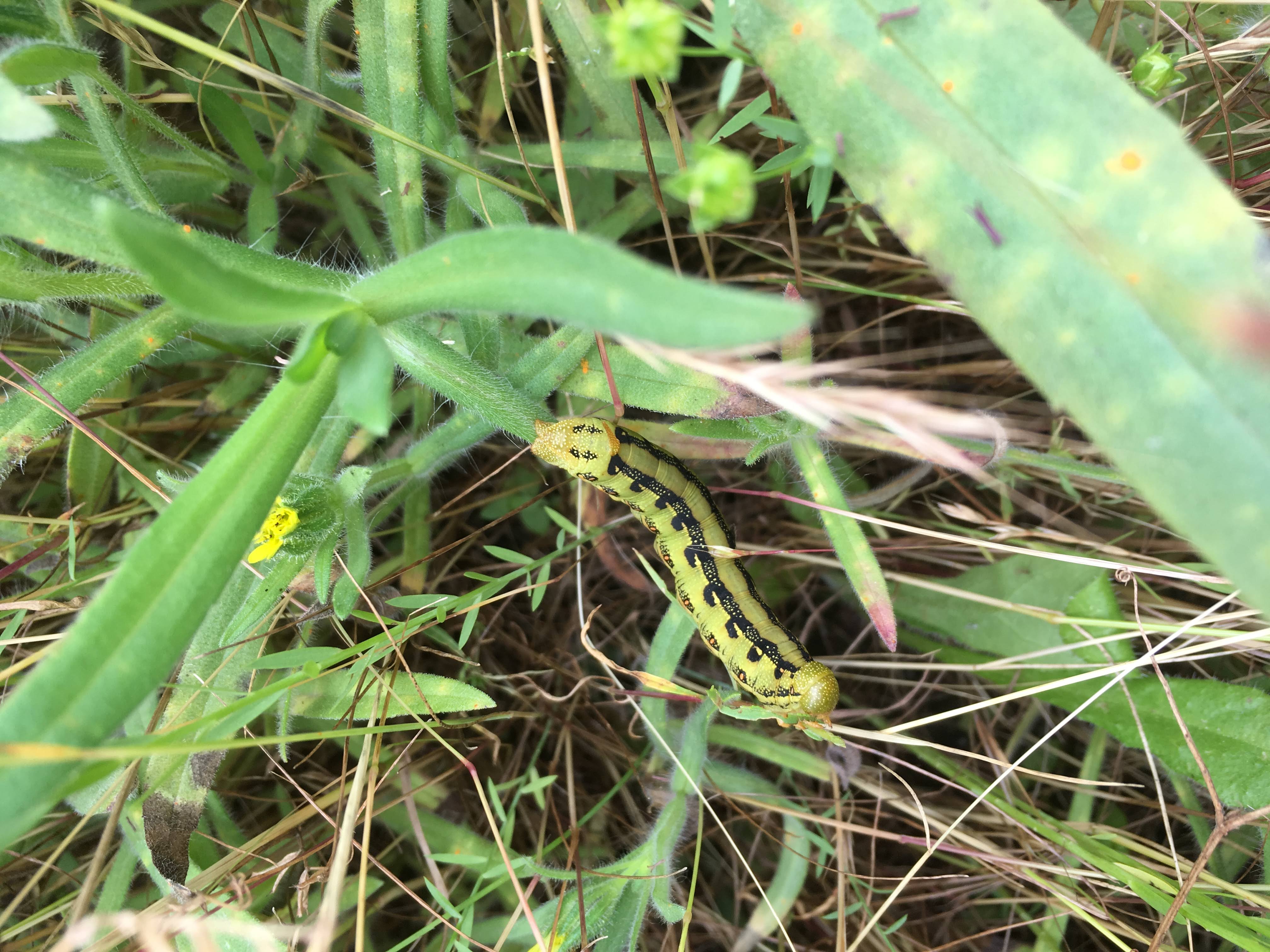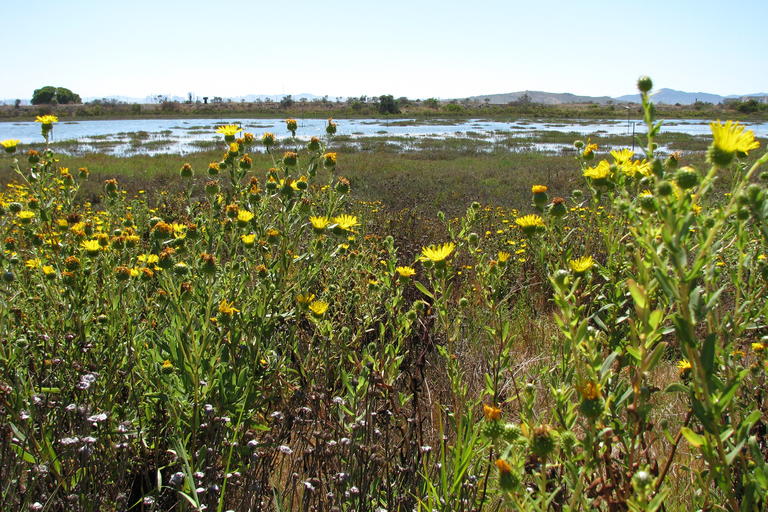This page provides photos of plants, animals and landscape at the Berkeley Global Campus at Richmond Bay including the Richmond Field Station Site and 3200-3300 Regatta Boulevard Property. If you would like to submit a photo for posting, please email EH&S with the photo and include information on the date, time and location, name of the photographer, and any other interesting information (such as the type of camera used).
Mammals
 Play slideshow
Play slideshow
Mammals

Gray foxes are small native canids (dogs) found throughout California. They have made the Richmond Field Station home for as long as anyone can remember. Gray foxes are omnivores and help control small mammal populations (rats and mice). Foxes are mostly active around sunset and sunrise.

In July 2015 a young fox kit stuck its head into a fence and could not extract itself. RFS Facilities Management staff rescued the fox by cutting the fence and releasing it back to the wild marsh edge.

Gray fox in trap November 2017. This fox was released back into the natural open space of the Richmond Field Station.


Coyote at night by animal cam. June 2017.

Pets are not allowed off-leash in the marsh or uplands where they disturb wildlife. These three dogs got loose from the Pt. Isabel dog park and made it all the way to the Richmond Field Station, where they somehow gotinto the marsh and began chasing birds during nesting season. It does provide a glimpse of what it might have been like here 10,000 years ago, albeit the edge of the coast closer to the Farrlones and the RFS being upland prairie at the time.
Birds
 Play slideshow
Play slideshow
Ridgway's Rail (Rallus longirostris)



Two rails


Common Yellowthroat (Geothlypis trichas)



The Wild Turkey, Meleagris gallopavo, is a recently re-introduced species, having been brought into the state during widespread introductions in the 1960s and 1970s by the Department of Fish and Game as a game species. There is some controversy regarding whether the species should be considered a non-native introduced species or a re-introduced historic species (see http://creagrus.home.montereybay.com/turkey-in-CA.html(link is external)). Regardless, the birds appreciate the nesting habitat and food availability at the RFS and have become part of the natural fauna.
Reptiles and Amphibians
 Play slideshow
Play slideshow
Reptiles and Amphibians

Pituophis catenifer catenifer. These snakes are nonvenemous and not harmful to humans. Their diet consists of small mammals and therefore they help control vermin populations on site. Please do not disturb them and look out for snakes on roadways and bike paths where they sometimes go to warm up.



The ring-necked snake or ringneck snake, is a harmless species of colubrid snake found throughout much of the United States, central Mexico, and south-eastern Canada. Ring-necked snakes are secretive, nocturnal snakes, so are rarely seen during the day time.
(Source: Wikipedia)

The Pacific Chorus Frog (Pseudacris regilla), also called the Pacific Tree Frog, is an abundant resident of the Richmond Field Station, breeding in poonded areas of seasonal wet meadows. It is the only known frog species at the RFS and one of the two speicies of the Class Amphibia Order Anura (frogs and toads) along with the Western toad (Bufo boreas) a probable but not verified resident of the RFS (Reference Gutstein, Joyce 1989).
Is it a chorus frog or tree frog? The Pseudacris regilla has commonly been called a "tree frog" and a "chorus frog". It turns out there is a difference between the two common names from a scientific phylogenic perspective. However, recently accumulated evidence has resulted in this species being confirmed to be in the chorus frog genus. This is well explained on Michael F. Benard's excellent website, Natural History of the Pacific Chorus Frog Psuedacris regilla at http://www.mister-toad.com/PacificTreeFrog.html#Names(link is external):
A note about names: Chorus frog or Tree frog
You may see these frogs referred to as either "Pacific Chorus Frogs" or "Pacific Treefrogs". The appearance of these two names hints at the debate among biologists about the relationship of Pacific Chorus Frogs to other North American frogs. The key question of the debate was whether Pacific Chorus frogs are members of the tree frog group (genus Hyla) or members of the chorus frog group (genus Pseudacris). Members of the genus Hyla include species like the gray treefrog (Hyla versicolor)(link is external) and the green treefrog (Hyla cinerea)(link is external), whereas members of the genus Pseudacris include species like the spring peeper (Pseudacris crucifer)(link is external) and the western chorus frog (Pseudacris triseriata)(link is external).
When pacific chorus frogs were first described by Baird and Girard in 1852(link is external), they were placed in Hyla. The genus Pseudacris had been described nine years earlier, by Fitzinger in 1843(link is external). Through the following decades, the pacific chorus frog continued to be considered a tree frog (Hyla), as shown in Cope's 1889 The Batrachia of North America(link is external), and in Stejneger and Barbour's 1917 A Check List of North American Amphibians and Reptiles(link is external). Over time, biologists began to note characteristics in which pacific chorus frogs were more similar to Pseudacris than Hyla. A neat example of this comes from Wright & Wright's 1933 Handbook of Frogs and Toads(link is external) in which they state "This species reminds the authors of species of Pseudacris." Hedges (1986 Systematic Zoology(link is external)) has a nice summary of some of these traits. For example, characteristics of Pseudacrisinclude (1) round testes with a dark membrane, (2) small toepads, and (3) breeding occurring during cold weather (i.e., in winter or early spring). In contrast, Hyla have (1) elogate pale-colored testes, (2) large toepads, and (3) breeding occurring during warm weather (i.e., late spring or summer). Pacific chorus frogs have dark testes and are cold-weather breeders, and their toepads are intermediate in size between other Pseudacrisand Hyla.
Even with the identification of some traits that linked pacific chorus frogs with the genus Pseudacris, it took time for enough evidence to accumulate to convincingly determine the affinity of pacific chorus frogs. The accumulating evidence included morphology, allozymes, nuclear sequence data and others (e.g., Hedges 1986 Systematic Zoology(link is external), Cocroft 1994 Herpetologica(link is external), Moriarty & Cannatella 2004 MPE(link is external), Pyron & Wiens 2011 MPE(link is external)). All of these data now convincingly show that Pacific Chorus frogs belong in the genus Pseudacris rather than the genus Hyla. Thus, it is appropriate to refer to them as "pacific chorus frogs" instead of "pacific tree frogs."

The RFS was likely formerly habitat for the California Red-Legged Frog (Rana aurora draytonii) now a federally listed threatened species under the Endangered Species Act. Contra Costa and Alameda Counties contain the majority of known California red-legged frog occurrences in the San Francicso Bay Area but all are in eastern and central parts of the counties. The red-legged frogs was eliminated from the western lowland portions of these counties, including the RFS, particularly near urbanization. It is likely that the elimantion of red-legged frogs from the Richmond area was caused mostly by loss of pond habitat and stream habitat fragmentation with additional loss from over hunting and introduction of non-native predators, such as bull frogs (Rana catesbeiana). After California statehood, Richard Stege purchased property of the former Rancho San Pablo along the Richmond Southeast Shoreline and raised frogs in ponds for sale to San Francisco restaurants. Stege probably raised red-legged frogs, which were a popular wild-caught harvest, through the mid to late 1800s. In 1896 he introduced bull frogs from the east coast, probably speeding the loss of local red-legged frogs as described in the paper Pre-1900 Overharvest of California Red-legged Frogs: the Inducement for Bullfrog Introduction (Jennings, Mark R. and Hayes, Marc P., Herpetologica, 14(1), 1985, 94-103):
"The earliest introduction of R. catesbeiana is reported in a previously uncited paper by Heard (1904) who described a "frog farm" at Stege (= El Cerrito), Contra Costa County, California (see also Storer, 1933), where 36 bullfrogs were stocked in four artificial ponds in 1896. The bullfrogs are reported to have originated from "Baltimore," Maryland, and "Florida" (Heard, 1904). A shipment of 72 frogs sent to Hilo, Hawaii from Contra Costa County, California in October of 1897 (see Appendix I) is known to have had bullfrogs from the Stege "farm" (Cobb, 1902; Heard, 1904). The probable descendants from this introduction resulted in 172 kg of bullfrogs harvested in Hawaii in 1900 (Cobb, 1902). Some of these "Hawaiian bullfrogs" were later shipped to the San Francisco markets for sale (Alexander, 1905; Bryan, 1915; Storer, 1922). Storer (1925) also reported that Albert W. C. T. Herre (an ichthyologist at Stanford University) told him that bullfrogs were present in a creek at Los Gatos, Santa Clara County, California prior to 1910."
This is a photo of Stege at his frog ponds, believed to have been located at the current Booker T. Anderson park.
Invertebrates
 Play slideshow
Play slideshow
Invertebrates


The Genista Broom Moth (Uresephita reversalis) has a range covering much of the United States including California. Catepillars of the moth feed on plants of the pea family and can be found on native lupine, often consuming all of the leafy material and killing the plant. The following photos show moth catepillars on a Yellow Bush Lupine (Lupinus arboreus) grown from RFS plants seeds.


The white-lined sphinx moth (Hyles lineata) has a broad range covering much of the North American continent, north of Central America through southern Canada. The following photo shows themoth caterpillar in grasses in the Big Meadow of the RFS.
 Zoom
Zoom
Arrow Grass (Triglochin maritima)

Arrow Grass (Triglochin maritima) in Western Stege Marsh
 Zoom
Zoom
Coastal Terrace Prairie in Bloom

Mules ears (Wyethia angustifolia) and blue-eyed grass (Sisyrinchium bellum) bloom in spring at the Richmond Field Station coastal terrace prairie. (April 2016)
 Zoom
Zoom
Western Stege Marsh marsh gumplant (Grindelia stricta)

Ridgway's Rail (Rallus longirostris)
Ridgway's Rail (Rallus longirostris)
Ridgway's Rail (Rallus longirostris)
Canada Goose (Branta canadensis)
April 2016 rescue of Canada goose with broken foot. The goose was taken to Wildcare in San Rafael for care.
